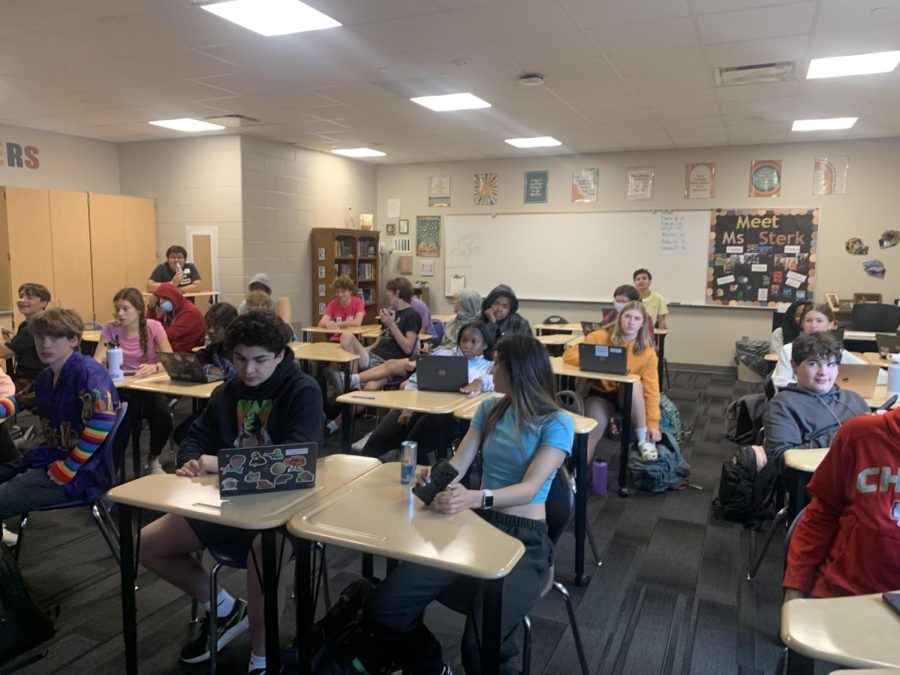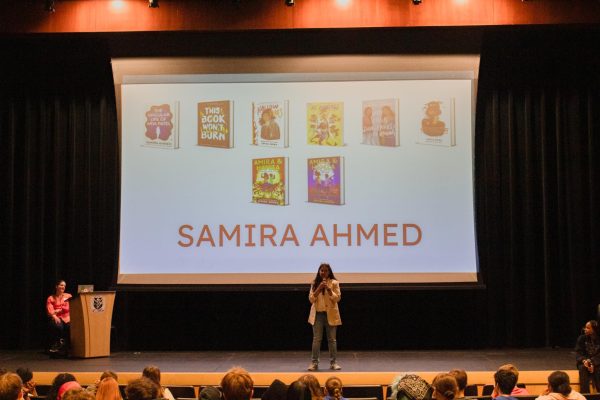Overflowing Classes and Overworked Teachers
As the number of kids in classrooms continue to grow, teachers struggle to keep up.
Schyler Sterk’s freshman English 9 class playing a game of Kahoot.
Imagine a classroom packed full of students. Every seat is filled and there are no open desks. This is what many teachers are facing today. Overcrowded classrooms have become a problem with many causes and solutions.
In recent years, the average number of students in classes has increased at a rate that schools and teachers are struggling to keep up with.
“[Class sizes] just keep getting bigger. I can remember when you would have 20 kids in a class, and then the cap became 25, and then 30, and now our cap is 32, but we’re consistently getting 36 and 38 [kids in a class],” says Peggy Dolson, English teacher.
Having too many kids in a class can affect not only a teacher’s ability to educate but also their students’ ability to learn. The stress from teaching overcrowded classes can also put a strain on a teacher’s mental health.
“I feel students are needier now than ever before and so those [large] class sizes are not helping anyone,” says Dolson. “You have so many more kids that you have to keep track of. Teachers are saying that they’re exhausted, that they’re overwhelmed. We’re so worried about students’ mental health but we need to have mentally healthy teachers as well.”
English teacher, Zach Lively, also has experienced issues with having too many students in a classroom.
“Currently, my largest class is 35 students,” says Lively, “Getting to every individual student can be difficult, just because there’s so many [students] and not enough time for me to have an individual interaction with everyone.”
There are very few, if any, positives to having a larger number of students in a class.
“I don’t know if there are any benefits of larger classes… you increase your chance of diversity, if you have 35 kids there’s a chance that you might get students that aren’t all alike,” says Dolson.
On the other hand, there are many struggles that teachers have found in trying to teach a larger class. For example, teachers have had to adjust their strategies in order to accommodate their students. “The strategies have definitely changed from less full-class work and more small-group or individual work,” says Lively, “In large-group settings, it’s hard for everyone to get their voices in.”
The main cause of the increase in class sizes is a lack of teachers. According to Education Week, about 8% of teachers are leaving the profession each year. That number, along with the teacher burnout caused by the COVID-19 pandemic caused schools to be facing massive staffing shortages.
“[Class sizes are increasing because] they’re not hiring enough teachers,” says Dolson, “It has to start with human resources. They have to look at ways that we can re-allocate more funding so that we can have more teachers.”
According to Iowa City Schools, during the 2019-2020 fiscal year, approximately $150,000,000 of the district’s $396.8 million budget went into employee costs. This included staff salaries and benefits for the 2000+ employees that year. The average teacher salary in the ICCSD is $54,883 per year compared to the national average salary of a public school teacher of $65,090 per year, according to Glassdoor.
The constant increase in the number of students in a classroom will continue to affect students and teachers until more teachers are hired and teachers are paid the higher salaries that they deserve.

Kaelyn is a senior at Liberty, and this is her third year on the Live Wire staff. At Liberty, she participates in NHS, garden club, SEA club, and softball....








